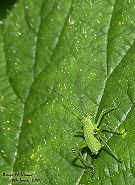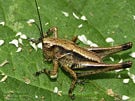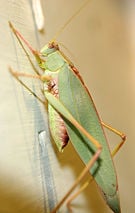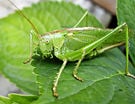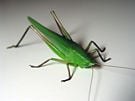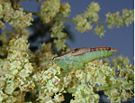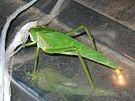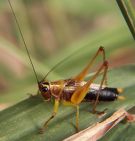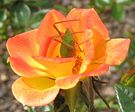Difference between revisions of "Tettigoniidae" - New World Encyclopedia
Rick Swarts (talk | contribs) |
Rick Swarts (talk | contribs) |
||
| Line 1: | Line 1: | ||
| − | |||
{{Taxobox | {{Taxobox | ||
| name = Tettigoniidae | | name = Tettigoniidae | ||
| Line 39: | Line 38: | ||
*[[Zaprochilinae]] | *[[Zaprochilinae]] | ||
}} | }} | ||
| + | '''Tettigoniidae''' is a major family of long-horned grasshoppers in the suborder Ensifera of the order [[Orthoptera]], characterized by strong hind limbs for leaping, powerful mouth-parts for chewing, four tarsal segments, long and threadlike [[antenna (biology)|antennae]] (which have well over 30 segments and may exceed their own body length), stidulatory specializations of the forewings to make sounds, and a left over right overlap of the singing wings in males. Members of Tettigoniidae are known by the common name of '''katydids''' in the New World, Australia, and New Zealand, and '''bushcrickets''' in Europe, while the term '''long-horned grasshoppers''' is also used in some locations (sometimes in Australia and New Zealand as well), but sometimes also applies to members of Ensifera in general. | ||
| + | |||
| + | Katydids are a very large group, with more than 6,400 species in over 1000 genera, and can be quite large (1 to 6 centimeters). They are found on all continents except Antarctica. | ||
| + | |||
| + | |||
| + | |||
| + | |||
| + | ==Overview== | ||
The [[family (biology)|family]] '''Tettigoniidae''', known in [[American English]] as '''katydids''' and in [[British English]] as '''bush-crickets''', contains more than 6,400 [[species]]. It is part of the suborder [[Ensifera]] and the only family in the superfamily Tettigonoidea. They are also known as '''long-horned grasshoppers''', although they are more closely related to [[Cricket_(insect)|cricket]]s than to grasshoppers. | The [[family (biology)|family]] '''Tettigoniidae''', known in [[American English]] as '''katydids''' and in [[British English]] as '''bush-crickets''', contains more than 6,400 [[species]]. It is part of the suborder [[Ensifera]] and the only family in the superfamily Tettigonoidea. They are also known as '''long-horned grasshoppers''', although they are more closely related to [[Cricket_(insect)|cricket]]s than to grasshoppers. | ||
Tettigoniids may be distinguished from [[grasshopper]]s by the length of their [[antenna (biology)|antennae]], which may exceed their own body length, while grasshoppers' antennae are always relatively short. | Tettigoniids may be distinguished from [[grasshopper]]s by the length of their [[antenna (biology)|antennae]], which may exceed their own body length, while grasshoppers' antennae are always relatively short. | ||
| + | |||
| + | The suborder Ensifera (long-horned grasshoppers) consists of crickets and katydids. Members are characterized by fine and threadlike antennae with well over 30 segments (except fossil representatives), stidulatory specializations of the forewings to make sounds in those groups that sing, auditory organs (when present) linked via modified tracheae to the enlarged mesothoracic spiracles, and a six-valved ovipositor (Gwynne and Desutter 1996). | ||
The name "katydid" comes from the sound produced by species of the North American [[genus]] ''[[Pterophylla]]'' (literally "winged leaf"). The males of katydids have sound-producing [[organ (anatomy)|organs]] (via [[stridulation]]) located on the hind angles of their front wings, which in some species produce a [http://buzz.ifas.ufl.edu/141a.htm sound] thought to resemble the words "Katy did, Katy didn't", hence the name. In some species females are also capable of [[stridulation]]. | The name "katydid" comes from the sound produced by species of the North American [[genus]] ''[[Pterophylla]]'' (literally "winged leaf"). The males of katydids have sound-producing [[organ (anatomy)|organs]] (via [[stridulation]]) located on the hind angles of their front wings, which in some species produce a [http://buzz.ifas.ufl.edu/141a.htm sound] thought to resemble the words "Katy did, Katy didn't", hence the name. In some species females are also capable of [[stridulation]]. | ||
Revision as of 15:54, 10 November 2008
| Tettigoniidae
| ||||||||||||||
|---|---|---|---|---|---|---|---|---|---|---|---|---|---|---|
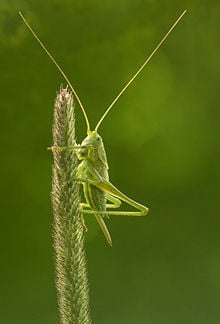 Great green bush-cricket
(Tettigonia viridissima) | ||||||||||||||
| Scientific classification | ||||||||||||||
| ||||||||||||||
|
Tettigoniidae is a major family of long-horned grasshoppers in the suborder Ensifera of the order Orthoptera, characterized by strong hind limbs for leaping, powerful mouth-parts for chewing, four tarsal segments, long and threadlike antennae (which have well over 30 segments and may exceed their own body length), stidulatory specializations of the forewings to make sounds, and a left over right overlap of the singing wings in males. Members of Tettigoniidae are known by the common name of katydids in the New World, Australia, and New Zealand, and bushcrickets in Europe, while the term long-horned grasshoppers is also used in some locations (sometimes in Australia and New Zealand as well), but sometimes also applies to members of Ensifera in general.
Katydids are a very large group, with more than 6,400 species in over 1000 genera, and can be quite large (1 to 6 centimeters). They are found on all continents except Antarctica.
Overview
The family Tettigoniidae, known in American English as katydids and in British English as bush-crickets, contains more than 6,400 species. It is part of the suborder Ensifera and the only family in the superfamily Tettigonoidea. They are also known as long-horned grasshoppers, although they are more closely related to crickets than to grasshoppers.
Tettigoniids may be distinguished from grasshoppers by the length of their antennae, which may exceed their own body length, while grasshoppers' antennae are always relatively short.
The suborder Ensifera (long-horned grasshoppers) consists of crickets and katydids. Members are characterized by fine and threadlike antennae with well over 30 segments (except fossil representatives), stidulatory specializations of the forewings to make sounds in those groups that sing, auditory organs (when present) linked via modified tracheae to the enlarged mesothoracic spiracles, and a six-valved ovipositor (Gwynne and Desutter 1996).
The name "katydid" comes from the sound produced by species of the North American genus Pterophylla (literally "winged leaf"). The males of katydids have sound-producing organs (via stridulation) located on the hind angles of their front wings, which in some species produce a sound thought to resemble the words "Katy did, Katy didn't", hence the name. In some species females are also capable of stridulation.
There are about 255 species in North America, but the majority of species live in the tropical regions of the world.
The diet of tettigoniids includes leaves, flowers, bark, and seeds, but many species are exclusively predatory, feeding on other insects, snails or even small vertebrates such as snakes and lizards. Some are also considered pests by commercial crop growers and are sprayed to limit growth. Large katydids can inflict a painful bite or pinch if handled but seldom break the skin.
The spike headed katydid is somewhat notorious for its plantlike appearance, which allows it to blend in with the vegetation on which it lives, and the spikes discourage potential predators.
The males provide a nuptial gift for the females in the form of a spermatophore, a nutritious body produced with the males' ejaculate. The katydid is a leaf-like insect which camouflages on leaves. The eggs of katydids are oval shaped and laid in branches and are laid in lines.
Photo gallery
|
File:Katydid by night.jpg Katydid in the night near Torino, Italy | ||
ReferencesISBN links support NWE through referral fees
Gwynne, Darryl T. and Glenn K. Morris. 2002. Tettigoniidae. Katydids, Long-horned Grasshoppers and Bushcrickets. Version 26 November 2002. http://tolweb.org/Tettigoniidae/13298/2002.11.26 in The Tree of Life Web Project, http://tolweb.org/
Gwynne, Darryl T. and Laure DeSutter. 1996. Ensifera. Crickets, katydids and weta. Version 01 January 1996. http://tolweb.org/Ensifera/13315/1996.01.01 in The Tree of Life Web Project, http://tolweb.org/
Gwynne, Darryl T., Laure DeSutter, Paul Flook, and Hugh Rowell. 1996. Orthoptera. Crickets, katydids, grasshoppers, etc.. Version 01 January 1996 (under construction). http://tolweb.org/Orthoptera/8250/1996.01.01 in The Tree of Life Web Project, http://tolweb.org/
External links
- Bush katydid genus Scudderia Stål, 1873 - diagnostic photographs, natural history
- Black-sided meadow katydid - Conocephalus nigropleurum - diagnostic photographs
- BugGuide.net—family Tettigoniidae
- Singing Insects of North America (SINA) website.
- Bug guide.net— Pink Katydid
- North American Katydids, with range maps and audio files of katydid songs.
Credits
New World Encyclopedia writers and editors rewrote and completed the Wikipedia article in accordance with New World Encyclopedia standards. This article abides by terms of the Creative Commons CC-by-sa 3.0 License (CC-by-sa), which may be used and disseminated with proper attribution. Credit is due under the terms of this license that can reference both the New World Encyclopedia contributors and the selfless volunteer contributors of the Wikimedia Foundation. To cite this article click here for a list of acceptable citing formats.The history of earlier contributions by wikipedians is accessible to researchers here:
The history of this article since it was imported to New World Encyclopedia:
Note: Some restrictions may apply to use of individual images which are separately licensed.
